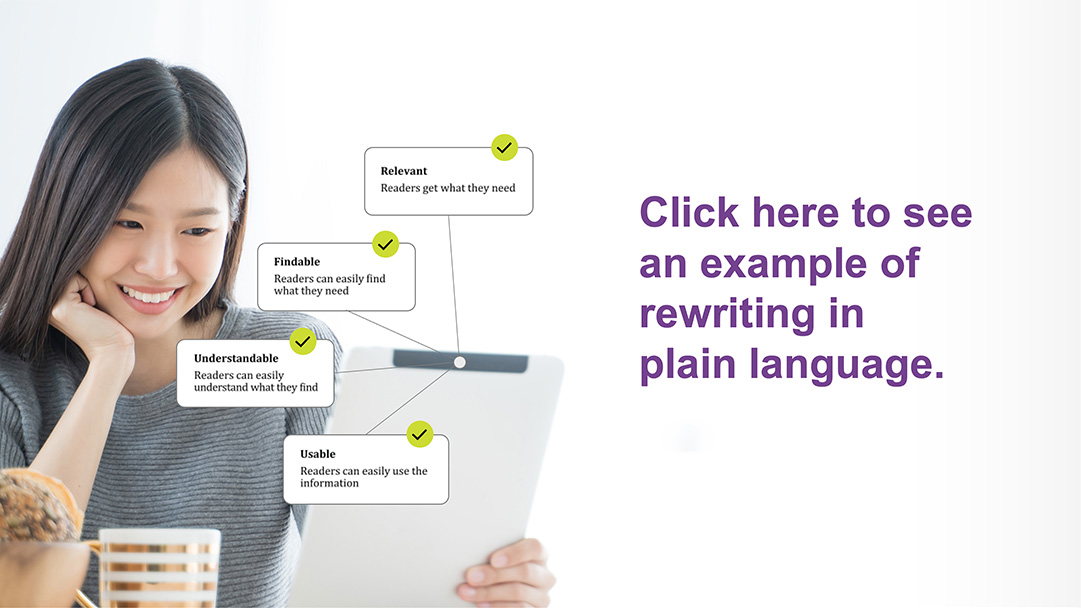Interested in seeing a demo?
Fill out the following information (please ensure you provide some detail on the problem you are looking to solve or the Messagepoint product you are interested in).

Clearly communicating with customers is crucial, particularly in regulated industries such as healthcare and financial services. Customers rely on these services to provide guidance and information when making life-altering decisions. Helping customers understand their options is more than just good customer service, it’s integral to driving positive outcomes and maintaining trust.
Unfortunately, customer communications in these sectors are often long and complex. Typically drafted by highly educated subject matter experts and edited by legal teams, these communications are written at a college level and are full of industry jargon and legalese, making them difficult for the average US consumer to understand. It is critical to consider the broader profile of the consumers of these services across the United States, where:
Plain language offers a path to clearer communication
The current lack of clarity that’s common in regulated customer communications reveals that the practices most organizations have in place are not sufficient. It’s clear that a new approach is required and that starts with adopting the right communication guidelines. Plain language writing is designed to make communications clear and accessible to a wider audience. The concept of plain language took off in the 1970s when government organizations began to recognize issues with communications and wanted regulations to be written in “layman’s terms”. Various organizations have developed guidelines over the years to support its implementation. The standard developed by the International Organization for Standardization by plain language experts (ISO 24495-1) provides a comprehensive internationally recognized standard for organizations to adopt. The standard provides a detailed guide for plain language writing principles, providing specific recommendations for how plain language should be written and structured. From a customer communications perspective, the relevant best practices are:

The challenge in adopting plain language
Most organizations probably recognize the importance of clear communication and aspire to meet plain language standards. What often stops content optimization initiatives from getting off the ground is how difficult, time consuming, and costly these projects can be, especially for those with outdated CCM systems in place. Team members would have to comb through hundreds, potentially thousands, of communication templates to identify and rewrite unclear content. Multiple authors and teams are often involved, each with their own preferences and varying levels of experience, which makes consistent application of plain language standards extremely difficult. And even if a project were completed, there’s often nothing in place to enforce the new standard going forward which makes it likely that issues will resurface over time.
Effectively harnessing generative AI for plain language
Generative AI platforms are renowned for their ability to rapidly generate high-quality content. Rewriting content for plain language is something which is well within the capacity of tools like ChatGPT and Google’s Bard. But just because they have this capability does not mean by using them you will end up with a process that’s more efficient and consistent than the one outlined above.
Using these tools on their own means having to craft your own prompts. Prompts are the instructions given to Generative AI tools which are used to generate their responses. The multifaceted nature of plain language writing, coupled with the need for accuracy within customer communications content, makes it difficult to get results, especially on the first try. While it’s possible to improve the tool’s responses with additional prompts, this iterative process can easily take longer than simply rewriting the content yourself. To avoid this, you need prompts that consistently produce content rewritten to plain language standards and that has its original meaning and purpose intact. This level of prompt engineering is currently possessed by a small group of experts who have the unique combination of AI proficiency and nuanced understanding of regulated customer communications requirements.
Another consideration is that using these tools in isolation, disconnected from where the content lives, is the amount of time you will spend manually transferring their content between systems, and adding back the variable content or formatting which was lost during the process.
Recognizing these issues, some modern CCM platforms have incorporated generative AI capabilities into their platforms, offering companies the opportunity to leverage generative AI within the same environment where their content is managed. However, it’s important to consider that not all of these platforms are equally equipped to help you tackle plain language issues.
Look for a CCM platform with plain language prompts that are pre-programmed functions within the system. These vendors have leveraged their expertise in AI and CCM to engineer these prompts to deliver high quality results consistently. This not only saves your team from having to write their own prompts, but it ensures the consistent application of plain language principles throughout all your customer communications since everyone uses the same prompt.
CCM platforms which enable a highly efficient modular approach to content management provide especially strong benefits. Using this approach, common content objects, like regulatory disclosures and Terms & Conditions, which appear over and over across your communications library can be centrally controlled from a single point of change. This means that you only need to optimize this content once and the update will be instantly reflected in every communication where that content appears.
It’s also important to keep in mind that rewriting content is only half the battle. The other critical component is identifying unclear content in the first place. CCM platforms which have additional AI-powered capabilities for analyzing content can address this challenge. These AI tools can perform corpus-level analysis and provide insight into the overall readability of your communications and enable you to pinpoint exactly which content you should improve. It can also assist content authors by analyzing the content they are writing and providing real-time feedback on its readability, which helps to prevent clarity issues from reoccurring in the future.
Plain language may not be optional for very long
Regulators, both in the US and internationally, are increasingly working to remove these barriers to understanding by putting guidelines, and in some cases, legislation in place to mandate the use of plain language principles. In July, the UK’s Financial Conduct Authority new Consumer Duty legislation came into effect, which requires financial institutions to use “plain and intelligible language” in their customer communications or face heavy fines. In the US, the Plain Writing Act, which applies to federal agencies, also mandates that all communications be written in plain language. Today, there is no sweeping federal plain language requirements for the private sector in the US, however a blog published in February of 2023 by the Consumer Financial Protection Bureau (CFPB) indicates that this might not be far away. It states that ensuring communications are “equitable, accessible and easily understood” is one of their top priorities and that the recommendations they make in the piece are just a “first step”.
The introduction of such legislation would pose a significant challenge for many organizations, especially those relying on outdated customer communications management (CCM) platforms. The emergence of generative AI has presented a unique opportunity for organizations looking for an efficient way to optimize their content for plain language. But to take advantage, careful consideration of how its implemented is required.

November 13, 2023 – Messagepoint announced today enhancements to its generative AI capabilities to further support organizations in…
Read the Article